The Internet of Things (IoT) is picking up the pace. It revolutionizes the way companies function and improves daily life. IoT provides more intelligent, more connected experiences. The potential of IoT is enormous and growing, and McKinsey estimates it to be $12.5 trillion worldwide by 2030. IoT app development is central to making this technology a reality. It allows for frictionless communication between devices, users, and the networks that link them. From controlling smart household devices to monitoring health information, IoT applications streamline. They enhance decision-making and open doors.
But what is required to develop a successful IoT application? Well, It is not a matter of simply plugging in an appliance and connecting it to the web. Successful IoT development requires the integration of hardware, software, and network technologies. It offers security, scalability, and frictionless functionality. It’s about creating applications that perform well and provide real value. Companies can automate processes, and customers will enjoy more convenience.
Here, in this blog, we are going to plunge into the main steps to develop an IoT application. We have also covered the fundamentals of IoT applications, the cost of building a successful IoT application, and the use cases of IoT applications. Rest assured, we’re here to help you develop an IoT solution that impacts people’s lives. Let’s learn how to make your IoT dream come true! Let’s get started:
What is IoT?
The Internet of Things (IoT) refers to a network of physical objects, vehicles, appliances, and other items. These objects are equipped with sensors, software, and connectivity, enabling them to sense and exchange data.
IoT devices, or “smart objects,” vary from basic smart home devices such as thermostats to wearables such as smartwatches. They can also be sophisticated machinery and transport systems. The idea even goes so far as to create “smart cities.”
IoT enables devices to integrate smart features, creating a huge network. This network makes devices capable of sharing data and completing tasks independently. A few examples are:
- Tracking weather conditions in farms
- Controlling traffic flows with intelligent cars
- Regulating equipment and processes in factories
- Monitoring shipments and stock in warehouses
The possible use of IoT is enormous, reaching across manufacturing, transportation, health, and farming industries. IoT will keep redesigning the world as the devices connected increase in number.
Components Of IoT Application
The effective functioning of an IoT system relies on various critical components that collaborate to provide effective, connected solutions. These components are the foundation of every IoT application, facilitating data acquisition, communication, analysis, and user interaction. Let’s consider the critical components that drive IoT systems:
Sensors: Gathering Key Data
Sensors play a vital role in IoT systems, taking readings such as temperature, movement, and humidity. They translate physical states into usable data. For instance, motion sensors in intelligent homes activate security notifications, while temperature sensors keep indoor conditions under observation. Accuracy in the sensors is vital to provide trustworthy, useful data. Sensor technology has developed to the extent of gathering more accurate data, enhancing IoT applications such as predictive plant maintenance in factories.
Connectivity: Facilitating Trustworthy Communication
Connectivity is essential for IoT devices to communicate seamlessly with one another. Technologies like Wi-Fi, Bluetooth, Zigbee, and cellular networks offer different strengths in terms of range, power, and data rate. Wi-Fi is ideal for high-speed, short-range applications. Bluetooth on the other hand, is suitable for short-range, low-power devices. Zigbee is suitable for industrial applications, whereas cellular networks are best for applications requiring a wide area. Choosing the appropriate solution is important for reliable and secure IoT operation.
Data Processing: Interpreting and Analyzing Data
Data processing converts gathered data into information with the help of algorithms. Edge processing processes data locally, cutting latency for real-time applications, whereas cloud processing deals with large-scale data and long-term storage. Cloud platforms can refine smart city traffic or health data, with scalability and flexibility. Engineers must master data processing methods to convert raw data into actionable intelligence to enhance decision-making and efficiency.
User Interface: Interaction with IoT Systems
The user interface (UI) plays a central role in operating IoT systems and observing data. UIs are available in mobile applications, web dashboards, or voice-controlled assistants, assisting users in communicating with devices. For instance, smart home applications enable remote appliance control, while dashboards observe industrial machinery. An effective UI simplifies complicated data to interpret and engage with, providing an intuitive user experience. Engineers need to concentrate on developing intuitive, user-friendly UIs to increase adoption and satisfaction.
Features Of IoT
A few key features form the foundation of IoT, allowing it to function with connectedness, automation, and intellect. Such features ensure smart devices communicate fast, analyze data as it comes in, and improve user experiences. Here are the core features that help to make IoT systems effective:
Connectivity: ensures a link between high-performance IoT devices to a server, cloud server, etc. It allows secure, reliable, and bi-directional high-speed messaging.
Analyzing: involves pulling up real-time data to get an insight into the best available business approach. A system is said to be ”intelligent” when it properly assesses the data collected.
Integrating: different models together can enhance the user experience and have the system cross-check itself.
Artificial Intelligence: uses data to make devices smarter. For example, a coffee machine can sense when it has low levels of beans and order more for itself automatically.
Active Engagement: delivers the capabilities for devices, products, and services to interact seamlessly with each other.
Tech Stack To Create A Successful IoT Application
For an IoT application to be successful, you need to have an effective tech stack with a correct assortment of tools for each component. This includes the selection of programming languages, frameworks, cloud providers, communication protocols, hardware, and sensors. Below is a list of the components you will need for your IoT app, and you can customize this list based on your/projects. If you are not confident, don’t hesitate to talk to our experts, tailored to you.
| Category | Technologies |
|---|---|
| Programming Languages | C/C++, JavaScript, Python, Ruby |
| Frameworks | Node.js, IoT.js, Device.js, Angular |
| Cloud Platforms | Arduino (open-source), AWS IoT, Google Cloud IoT, IBM Watson, Microsoft Azure IoT, OpenHAB |
| Protocols | 2G/3G/4G/LTE/5G, AMQP, MQTT, Wi-Fi |
| Hardware | Arduino, FPGA controllers, Google TPU, Raspberry Pi |
| Sensors | 1-Wire, ADC, Analog, RF433, RFID |
Steps To Build A Successful IoT Application
We recommend creating a minimum viable product (MVP) to quickly validate your idea. By gathering early customer feedback, you can refine your product for better performance and relevance. We’ve outlined key development steps to build high-quality IoT products that encourage repeat usage and long-term success.
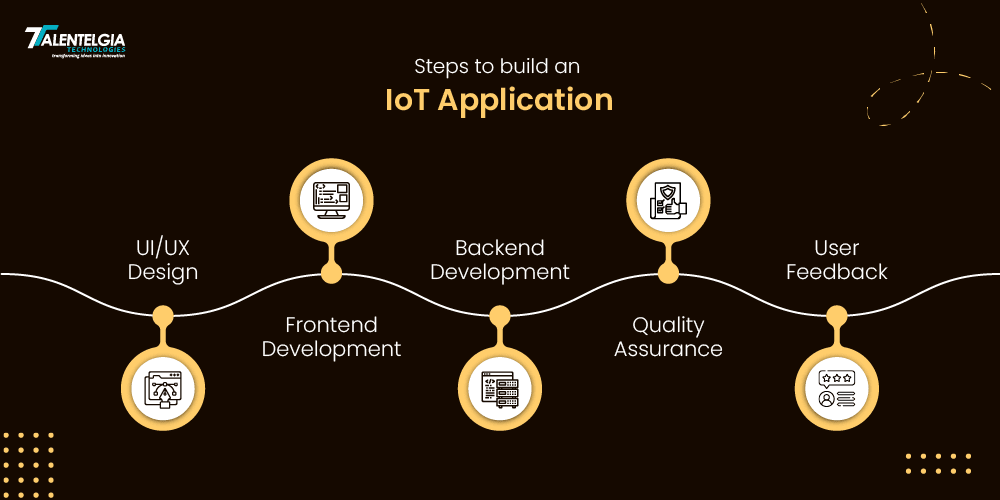
Step 1: UI/UX Design
To begin with, an IoT app’s design needs to be not only good-looking but also easy to use. Effective user interface design and user experience design are important when it comes to differentiating an app in the competitive market. If users don’t find an app easy to navigate or even have broken links, they won’t hesitate to leave negative ratings. This affects the reputation of your app as well as influences the download volume. To avoid this, make sure that the user flow is easy to understand and that buttons function as they should, making the experience smooth and enjoyable.
Step 2: Frontend Development
Once the design is established, front-end development is the next step. One of the most widely utilized programming languages for creating IoT app frontends is JavaScript. Other popular frameworks such as Angular, React, or Vue offer highly effective tools that accelerate development and improve user experience. Based on your project requirements and the team’s interests, you may use a framework that best suits your needs. This selection ensures the app’s interface becomes both functional and interactive for users.
Step 3: Backend Development
Once you have established the front end, the back end becomes the priority. The server-side app is developed at this stage, and tool selection becomes crucial here. If the frontend is designed with JavaScript, Node.js follows as a perfect fit for the backend. When databases are managed, tools such as CrateDB, MongoDB, or SQLite are dependable choices to ensure hassle-free management of data. Furthermore, DevOps software such as Gradie, Jenkins, or Docker automates deployment, thereby increasing the overall development efficiency.
Step 4: Quality Assurance — Manual or Automated Testing
Once the above steps are cleared, you need to test your application to ensure that it is working as expected. Quality assurance (QA) is a significant process to check any bugs or vulnerabilities before deployment. Whether you are performing automated testing or manual testing, you need to fix the bugs to provide a secure and hassle-free user experience. You will also gain a good reputation and avoid negative reviews by being ready to quickly respond to any user bug reports after your initial launch.
Step 5: Get Feedback from Users and Enhance Your App
Once you’ve released your app, the next thing to do is collect useful feedback from your first users. Their input can inform changes and influence future updates to your app. It’s worth making a roadmap of future fixes or features and publishing this to your users. By being open and demonstrating a commitment to ongoing improvement, you gain trust and make users feel appreciated.
Giving Importance to Data Privacy and Security in IoT Application Development
Lastly, as you develop your IoT app, remember that data protection and privacy precede all. Incorporating end-to-end encryption, routine security audits, and compliance with regulations by privacy laws such as GDPR and CCPA are the key things to remember to maintain user confidence. Safe authentication and surveillance in real-time will also guard your app against access by illegitimate means or becoming a target of cyber attacks. These habits are essential to building a secure, stable IoT app that will be trusted by users and remain in use.
Top 5 Best Examples Of IoT Applications
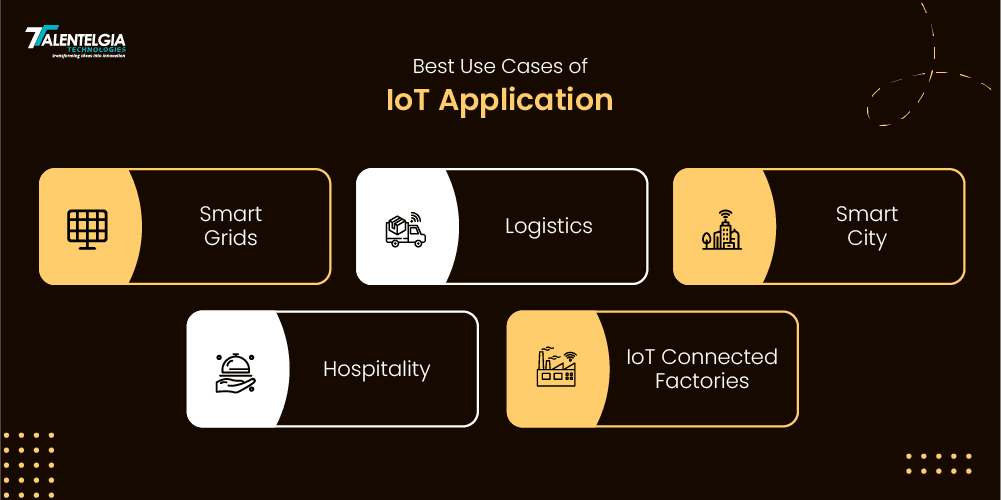
1. Smart Grid
A smart grid is a modernization of the electricity supply system using digital technology to monitor and manage the transport of electricity from all generation sources. It regulates the movement of electrical energy from power stations to buildings, thus being time-tested, dependable, and profitable. IoT applications help scale smart grids for energy savings and electricity reforms.
For example, Chattanooga, Tennessee, has deployed a smart grid to reduce power outages. The city’s Electric Power Board monitors electricity infrastructure in real-time, responding more quickly and saving millions of dollars to get the lights back on.
2. Logistics
Currently, IoT applications & devices are revolutionizing logistics by providing real-time monitoring, predictive maintenance, cost-efficiency, and route optimization. These advances improve visibility and automation significantly. DHL, the global courier, embodies this approach by deploying sensors and machine learning to track the location and temperature of their shipments so that sensitive goods can be transported under the right conditions. Fleet management is also getting a revolution with IoT app development. Companies such as UPS place sensors in vehicles to monitor vehicle health, driver behavior, and fuel consumption. The gathered data which is collected is used for predictive maintenance, driving safety, and productive operational performance. No matter if you’re a small courier or a large corporation, the right IoT strategies can optimize several aspects of your operations and ultimately make your business more profitable.
3. Smart Cities
These IoT applications in smart cities improve efficiency and the quality of life by changing urban functions. IoT enables better traffic management, makes government services smarter, better use of resources, and reduces waste in cities. This makes for lasting economic growth and environmental benefits. For instance, Barcelona has even deployed sensor-based smart streetlights that save energy by adjusting brightness according to the circumstances. Likewise, Singapore’s Smart Nation initiative has deployed sensors and cameras to keep track of street cleanliness and crowd density, facilitating proactive city management.
4. Hospitality
The hospitality and tourism sectors are seeing the benefits of automation with IoT, improving guest experience while maximizing efficiency. Hilton’s Digital Key app enables guests to forgo the front desk, choose rooms, and unlock doors with their smartphones. Additionally, they can manage various aspects of a room, such as temperature, illumination, and entertainment, enhancing convenience and energy efficiency.
5. Factories
IoT-enabled factories are revolutionizing the manufacturing industry with the Industrial Internet of Things (IIoT). By connecting equipment and factory components to sensors, they form networks that allow for real-time data analysis. This results in improvements such as lower energy usage, improved asset tracking, and the detection of early equipment problems. At Siemens’ Amberg Electronics Plant in Germany, almost 75% of the operations are automated with IoT solutions. Factory equipment sensors monitor production lines, detect bottlenecks, and minimize waste. They also monitor machine performance, forecast maintenance requirements, and avoid expensive breakdowns.
Cost Of Building An IoT Application
Understanding the Average Costs of IoT ApplicationsDeveloping IoT applications is not simple, even before looking into the average costs. These include:
- App complexity, i.e., the number of features and incorporation of AI or ML.
- Security specifications, such as authentication mechanisms and general security capabilities.
- How many APIs will be required to be integrated?
- It is the application domain of the operating system.
- The nature of the application class — mobile or web-based.
- The number of screens involved — complexity of the UI/UX design.
Keeping these factors in mind, the IoT application development costs in current market scenarios are:
| App Complexity | Features | Estimated Cost |
|---|---|---|
| Basic IoT App | Limited device connections, basic data rendering | $30,000 – $40,000 |
| Advanced IoT App | Geolocation, payments, multi-device sync, third-party APIs, data encryption, enhanced security | $50,000 – $80,000 |
| Cost Factors | Country, company size, developer hourly rates | Varies |
This gives a clear breakdown of how different factors influence IoT app costs.
How Talentelgia Technologies Can Help?
As an IT consulting company – Talentelgia technologies is here is to convert your idea into reality. We offer end-to-end IoT application development solutions that make your projects innovative, secure, and scalable by leveraging our deep expertise. We focus on every detail of your development process — building intuitive user interfaces, connecting devices, and processing data. We understand your needs, and our team works with you to create custom solutions that increase efficiency and improve the user experience. With our expert guidance, you can overcome the challenges of IoT development and build applications that have a lasting impact.
Conclusion
While developing an IoT application might not look easy, a well-planned approach with a focus on smarter devices, seamless communication, and robust security will enable businesses to build high-impact solutions that drive experiences and progress.
A basic knowledge of the development process is essential for engaging in the vast possibilities offered by the IoT, which continues to develop. Leveraging the right technologies with best practices can help developers and organizations realize new opportunities and put them on the path to becoming part of the ever-expanding IoT ecosystem that works towards more intelligent and connected environments.


 Healthcare App Development Services
Healthcare App Development Services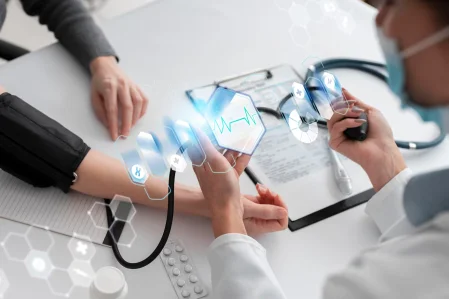
 Real Estate Web Development Services
Real Estate Web Development Services
 E-Commerce App Development Services
E-Commerce App Development Services E-Commerce Web Development Services
E-Commerce Web Development Services Blockchain E-commerce Development Company
Blockchain E-commerce Development Company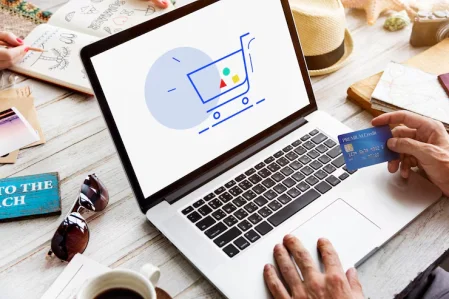
 Fintech App Development Services
Fintech App Development Services Fintech Web Development
Fintech Web Development Blockchain Fintech Development Company
Blockchain Fintech Development Company
 E-Learning App Development Services
E-Learning App Development Services
 Restaurant App Development Company
Restaurant App Development Company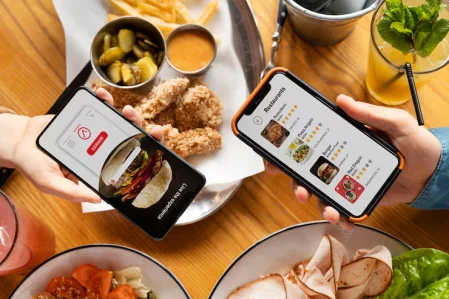
 Mobile Game Development Company
Mobile Game Development Company
 Travel App Development Company
Travel App Development Company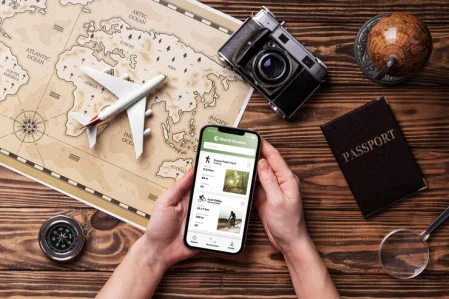
 Automotive Web Design
Automotive Web Design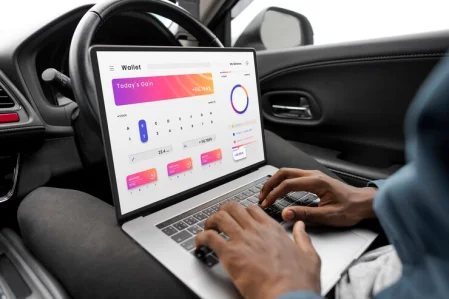
 AI Traffic Management System
AI Traffic Management System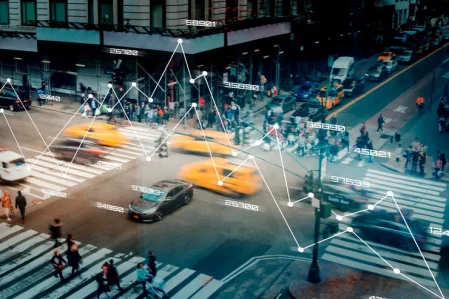
 AI Inventory Management Software
AI Inventory Management Software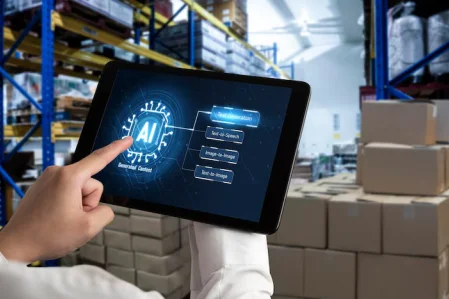
 AI Software Development
AI Software Development  AI Development Company
AI Development Company  AI App Development Services
AI App Development Services  ChatGPT integration services
ChatGPT integration services  AI Integration Services
AI Integration Services  Generative AI Development Services
Generative AI Development Services  Natural Language Processing Company
Natural Language Processing Company Machine Learning Development
Machine Learning Development  Machine learning consulting services
Machine learning consulting services  Blockchain Development
Blockchain Development  Blockchain Software Development
Blockchain Software Development  Smart Contract Development Company
Smart Contract Development Company  NFT Marketplace Development Services
NFT Marketplace Development Services  Asset Tokenization Company
Asset Tokenization Company DeFi Wallet Development Company
DeFi Wallet Development Company Mobile App Development
Mobile App Development  IOS App Development
IOS App Development  Android App Development
Android App Development  Cross-Platform App Development
Cross-Platform App Development  Augmented Reality (AR) App Development
Augmented Reality (AR) App Development  Virtual Reality (VR) App Development
Virtual Reality (VR) App Development  Web App Development
Web App Development  SaaS App Development
SaaS App Development Flutter
Flutter  React Native
React Native  Swift (IOS)
Swift (IOS)  Kotlin (Android)
Kotlin (Android)  Mean Stack Development
Mean Stack Development  AngularJS Development
AngularJS Development  MongoDB Development
MongoDB Development  Nodejs Development
Nodejs Development  Database Development
Database Development Ruby on Rails Development
Ruby on Rails Development Expressjs Development
Expressjs Development  Full Stack Development
Full Stack Development  Web Development Services
Web Development Services  Laravel Development
Laravel Development  LAMP Development
LAMP Development  Custom PHP Development
Custom PHP Development  .Net Development
.Net Development  User Experience Design Services
User Experience Design Services  User Interface Design Services
User Interface Design Services  Automated Testing
Automated Testing  Manual Testing
Manual Testing  Digital Marketing Services
Digital Marketing Services 
 Ride-Sharing And Taxi Services
Ride-Sharing And Taxi Services Food Delivery Services
Food Delivery Services Grocery Delivery Services
Grocery Delivery Services Transportation And Logistics
Transportation And Logistics Car Wash App
Car Wash App Home Services App
Home Services App ERP Development Services
ERP Development Services CMS Development Services
CMS Development Services LMS Development
LMS Development CRM Development
CRM Development DevOps Development Services
DevOps Development Services AI Business Solutions
AI Business Solutions AI Cloud Solutions
AI Cloud Solutions AI Chatbot Development
AI Chatbot Development API Development
API Development Blockchain Product Development
Blockchain Product Development Cryptocurrency Wallet Development
Cryptocurrency Wallet Development About Talentelgia
About Talentelgia  Our Team
Our Team  Our Culture
Our Culture 
 Healthcare App Development Services
Healthcare App Development Services Real Estate Web Development Services
Real Estate Web Development Services E-Commerce App Development Services
E-Commerce App Development Services E-Commerce Web Development Services
E-Commerce Web Development Services Blockchain E-commerce
Development Company
Blockchain E-commerce
Development Company Fintech App Development Services
Fintech App Development Services Finance Web Development
Finance Web Development Blockchain Fintech
Development Company
Blockchain Fintech
Development Company E-Learning App Development Services
E-Learning App Development Services Restaurant App Development Company
Restaurant App Development Company Mobile Game Development Company
Mobile Game Development Company Travel App Development Company
Travel App Development Company Automotive Web Design
Automotive Web Design AI Traffic Management System
AI Traffic Management System AI Inventory Management Software
AI Inventory Management Software AI Software Development
AI Software Development AI Development Company
AI Development Company ChatGPT integration services
ChatGPT integration services AI Integration Services
AI Integration Services Machine Learning Development
Machine Learning Development Machine learning consulting services
Machine learning consulting services Blockchain Development
Blockchain Development Blockchain Software Development
Blockchain Software Development Smart contract development company
Smart contract development company NFT marketplace development services
NFT marketplace development services IOS App Development
IOS App Development Android App Development
Android App Development Cross-Platform App Development
Cross-Platform App Development Augmented Reality (AR) App
Development
Augmented Reality (AR) App
Development Virtual Reality (VR) App Development
Virtual Reality (VR) App Development Web App Development
Web App Development Flutter
Flutter React
Native
React
Native Swift
(IOS)
Swift
(IOS) Kotlin (Android)
Kotlin (Android) MEAN Stack Development
MEAN Stack Development AngularJS Development
AngularJS Development MongoDB Development
MongoDB Development Nodejs Development
Nodejs Development Database development services
Database development services Ruby on Rails Development services
Ruby on Rails Development services Expressjs Development
Expressjs Development Full Stack Development
Full Stack Development Web Development Services
Web Development Services Laravel Development
Laravel Development LAMP
Development
LAMP
Development Custom PHP Development
Custom PHP Development User Experience Design Services
User Experience Design Services User Interface Design Services
User Interface Design Services Automated Testing
Automated Testing Manual
Testing
Manual
Testing About Talentelgia
About Talentelgia Our Team
Our Team Our Culture
Our Culture
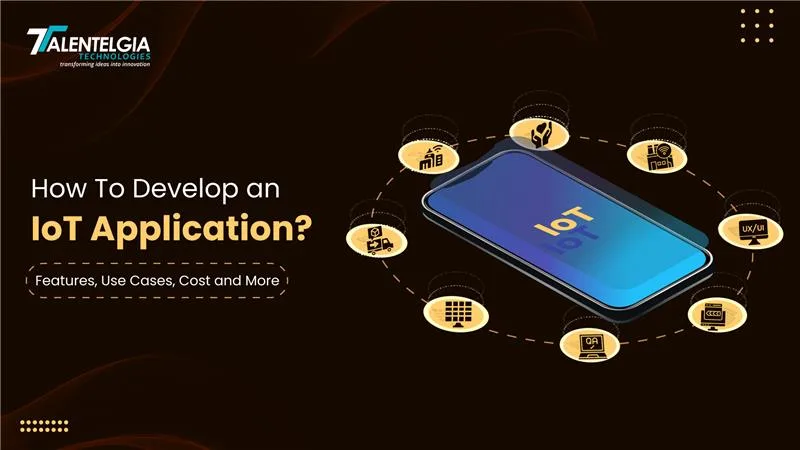

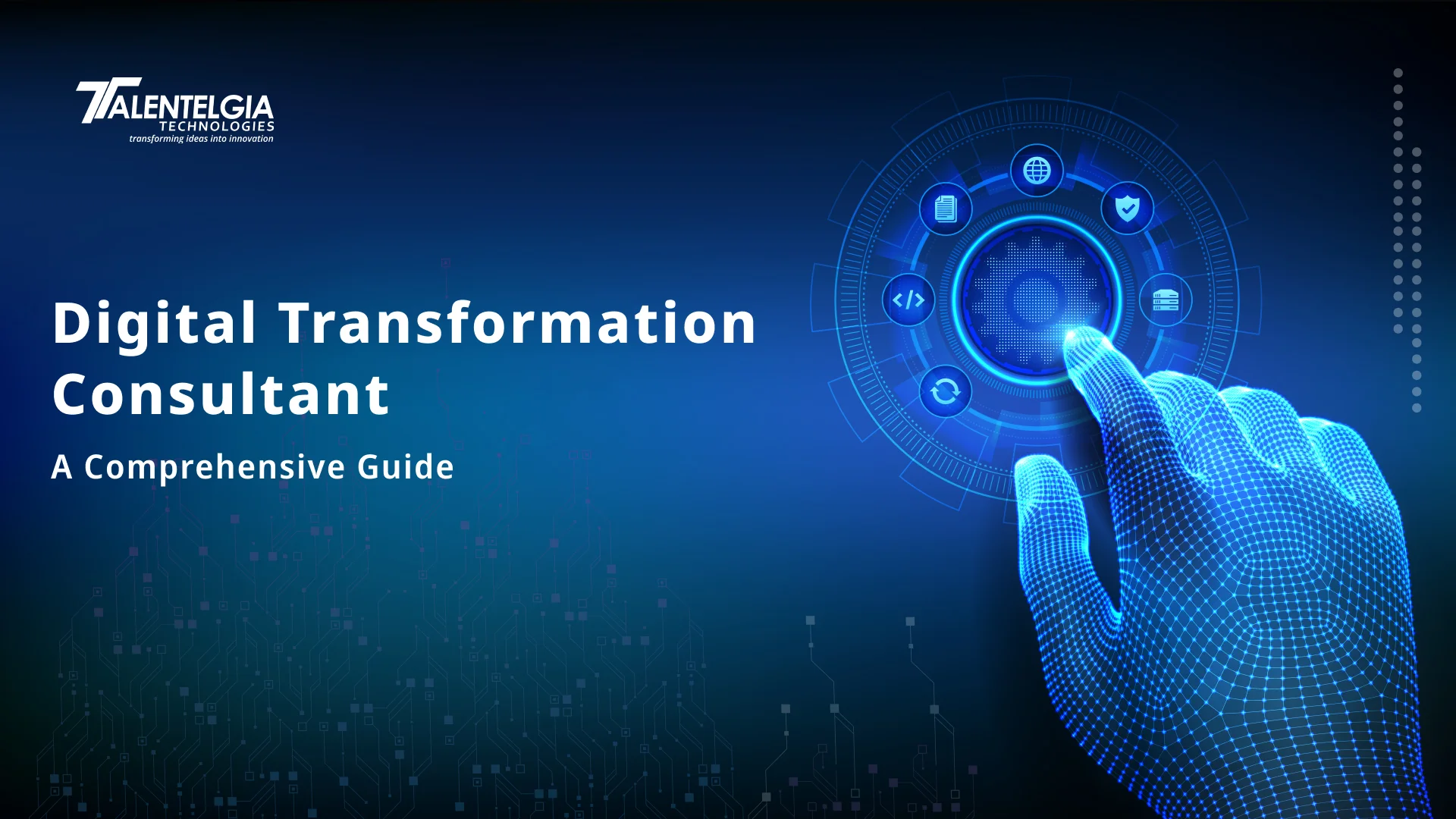











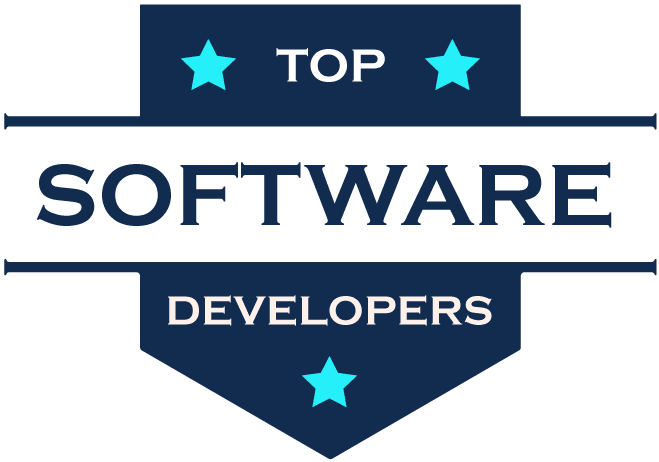
 Write us on:
Write us on:  Business queries:
Business queries:  HR:
HR: 




